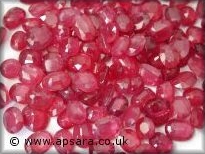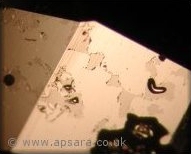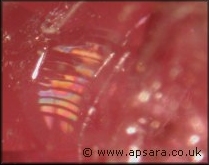Lead-Glass Filled Rubies
| In the latter part of 2004, red coloured corundum began to appear on the market in quantity, after being treated by a process known as pao mai (เผาใหม่) or new-burn* in English. The treaters in Thailand had discovered a new treatment process and were flooding the market with heavily fractured low grade red coloured corundum, which had been filled with lead-glass. The resulting product was a cheap 'ruby type' stone that could resemble a natural ruby to the untrained eye. These stones were being sold at source as pao mai rubies (พลอยแดงเผาใหม่) with full disclosure of treatments. There have however been problems with disclosure by resellers as the stones have been sold on. We should say at this point that it is our firm belief that gems which have undergone any treatment should be properly disclosed by the seller. |
 |
|
The treatment process involves heating the stones in the presence of lead and silicon oxides with fluxes at relatively low temperatures (~900°c-1400°c). During the treatment the oxides melt and seep into the surface reaching fissures and fill or 'repair' them with a residue. The difference in the refractive index of the residue and the surrounding corundum means the residue can sometimes be seen where it breaks the surface of the stone, occasionally even with the naked eye. The easiest way to observe the residue at the stone's surface, is to view the stone in reflected light or with fibre optic light. Under these conditions the duller lustre of the residue can be clearly visible (see image below). |
|
Examination with a loupe or microscope will reveal more. The filling resembles fillers I have seen in other types of rubies. Due to the difference in the R.I., the fillers or residues stand out in high relief. The filling can often show interference colours when examined in dark field illumination but clearer colours can be seen using a fibre optic light (see image below). Gas bubbles are also sometimes observed in these stones. Due to the relatively low temperatures used in the pao mai treatment, some inclusions normally affected by higher temperature treatments remain undisturbed. Sometimes it is possible to see un-dissolved rutile silk inclusions in these stones, which could lead the observer to miss-identify the stones as un-treated. |
|
|
|
Over the years we have taken the opportunity to examine many of these stones both before and after treatment. There are some common features seen in these stones which makes them relatively easy to identify. Some inclusions are quite common and diagnostic. Distinguishing inclusions can be seen with a microscope and fibre optic light. Some diagnostic features can be seen with a loupe or sometimes with the naked eye. |
Interference colours often seen in lead-glass filled corundum. |
|
Until the discovery of the lead-glass filling treatment, these lumps of corundum were only suitable for grinding up and using as abrasives. The starting material is mostly very low grade corundum from a variety of sources including Madagascar and Mozambique, which will often contain may surface reaching cracks or fissures. In the past the treatment was only performed on red coloured corundum but is now found in a variety of colours. It should also be noted that lead-glass blue coloured corundum is also treated with cobalt to improve the blue colour. Special care needs to be taken with these stones as the durability is poor. Heating the stone with a jeweller’s torch can cause the filling to come out of the stone. Cleaning in an ultrasonic bath can also cause damage to the stone. |
 |
| The price of cut and polished lead-glass filled corundum can be as low a $1 per carat and stones are available in large sizes. There is a place in the market for these stones and due to their relatively low cost, the best use for this material would seem to be in mass-produced costume or silver jewellery. The important thing is that however these stones are sold; they should be sold with full disclosure of treatment and details of any special care needed. |
***********************************************************************************************************************
|
*For the pedants amongst us; the Thai word 'pao' (เผา) in pao mai (เผาใหม่) translates to 'burn' in English. There is another word in Thai mai (ไหม้) which also translates to burn. Just to add to the confusion the word mai has many other different meanings in Thai depending on the way the word is pronounced. This could lead to great misunderstandings if for example there was a need to ask someone in Thai 'Does new wood burn?' - Mai mai mai mai? (ไม้ใหม่ไหม้ไหม). If you were to reply 'New wood does not burn.’ your reply would be Mai mai mai mai (ไม้ใหม่ไม่ไหม้). All these mais would be pronounced differently. :/ |











